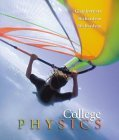Home
Research
Course-100B
Course-100A
Physics 100A
"College, Physics"
Department of Physics and Astronomy
California State University, Northridge
INSTRUCTOR: Armen Kocharian
Office SC1120C; Phone (818) 677-5203
SPRING 2005
Ticket Number: 13412
Meeting Time: 8:00-8:50 MWF
Lecture Room: SC1127
Office Hours: 9:50-11:10 pm M and by appointment

Objectives
This course of Physics 100A has the general aim: to gain an
understanding and appreciation of the fundamental laws of motions
and gravitation. At the end of the course, the successful students
will be able to recognize and appreciate many of the wonders
nature has in store. In addition, students will develop and
improve upon their problem-solving skills and learn to apply them
to other areas of their college education.
Main Topics
Kinematics in One and Two Dimensions, Dynamics Laws, Circular
Motion and Gravitation, Work and Energy, Conservation of Momentum,
Rotational Motion, conditions of Equilibrium, Theory of Fluids,
Oscillations.
Requirement
This course is a first half of the general Physics 100 A series
covering the chapters from 1 to 16 inclusive. It fulfills the
requirement of General Education in the physical
sciences by covering dynamics, statistics of particles and rigid
bodies, harmonic vibrations, and fluid mechanics. The final letter
grade, including plus/minus, for this course will be determined by
the scores from quizzes and assignments, two in-class
tests and the final exam. There will be 6 quizzes given over
the semester which will generally be about 10-15 minutes long held at
the end or beginning of the class and closed notes. The best way
to prepare for a quiz is to take a practice quiz at home timing
your effort. Each quiz will cover conceptual problems and the
material through the previous lectures, homework assignment and
the solved examples in the textbook. Only the 5 highest score for quizzes
will be considered. The final exam will be cumulative. There will be
weekly homework assignments and assigned problems are expected to
be solved by the date indicated and the students can check their
solution against the posted solutions on a web. The assigned
problems are by no means the only ones the students should attempt
to solve. They are just a set representative of the type of
problems the students should know how to solve. The attendance in
class is strongly recommended and counted.
TEXTBOOK: Giambattista, Richardson, Richardson -- College PHYSICS, Mc Graw Hill.

2004, ISBN: 0-0-07-052407-6, ISBN: 0-0-07-121462-3.
(You can purchase this book from CSUN bookstore or from Amazon.com by clicking on the image).
COURSE DESCRIPTION
- Introduction: Introduction to the Physics Science.
- Dynamics: Newton's Lawas:Force. Mass. Newton Laws. Free Body Diagram. Problem Solving.
- Friction Force: Newton Laws. Free Body Diagram. Problem Solving.
- Gravitation: Newton Gravitation Force. Satellites and "Weightlessness". Kepler Laws. Problem Solving.
- Kinematics in One Dimension: Uniform Motion. Uniform Acceleration. Free Fall. Problem Solving.
- Kinematics in Two Dimensions: Adding Vectors. Projectile Motion. Problem Solving.
- Work and Energy: Kinetic Energy. Energy Work Principle. Conservative and Nonconservative Forces. Law of Energy Conservation. Power. Problem Solving.
- Conservation of Energy: Conservative and Nonconservative Forces. Law of Energy Conservation. Power. Problem Solving.
- Linear Momentum: Momentum. Impact. Conservation of Momentum. Elastic Collision. Inelastic Collision. Collisions in One and Two Dimensions. Center of Mass. Problem Solving.
- Rotational Motion: Rotational Dynamics. Rotatioanl Kinetic Energy.Problem Solving.
- Torgue: Conservation of Angular Momentum. Inertial Forces.Problem Solving.
- Bodies in Equilibrium: The Condition for Equilibrium. Elasticity, Hook's Law. Problem Solving.
- Harmonic Motion:The simple pendellum. Amplitude and Period (Frequency). Resonance. Problem Solving.
MY SYLLABUS
Link to:
Course outline
PRACTICE QUIZ
Go to:
Your Practice Quiz 6
Go to:
Your Quiz 5
Go to:
Your Quiz 6
YOUR GRADE:
for Quizzes and Homeworks
PRACTICE TEST
Link to:
Practice Test II (Chapters 6-10)
HOMEWORK ASSIGNMENTS
HW1: 1, 10, 21, 36, 40.
HW2: 5, 9, 22, 32, 42.
HW3: 1, 7, 22, 32, 38.
HW4: 2, 16, 20, 27, 39.
HW5: 1, 11, 15, 32, 42.
HW6: 4, 18, 31, 37, 42.
HW7: 3, 13, 15, 27, 33.
HW8: 7, 13, 23, 32, 35.
HW9: 13, 28, 35, 41, 49.
Last Homework: Ch. 14: Problems 19, 26, 27, 35, 41 and Ch.
15: 4, 5, 7, 9, 11 (extra credit)
Link to:
Instruction Materials
and
Assignments
1. Read the assigned pages and work through the solved examples in the textbook.
2. Solve the assigned problems by the date indicated.
3. Check your solution against the posted solutions on a department web.
GRADING
The total score is accumulated as follows:
| Homework |
10% |
| Quizzes |
10% |
| Midterm Exam 1 |
25% |
| Midterm Exam 2 |
25% |
Final Exam |
30% |
| Total |
100% |
The grade distribution will be as follows: :
| A |
87% and higher |
| B |
75-86% |
| C |
60-74% |
| D |
45-59% |
F |
44% and below |
|

